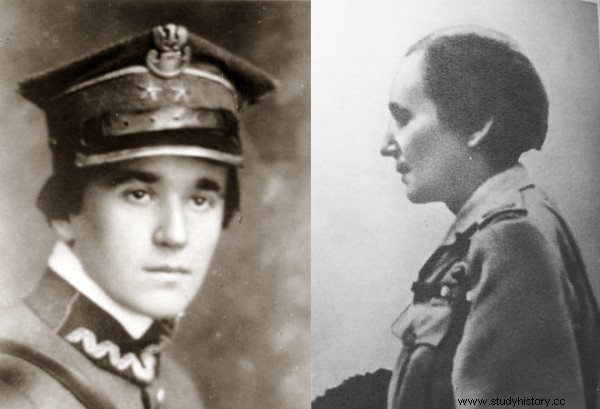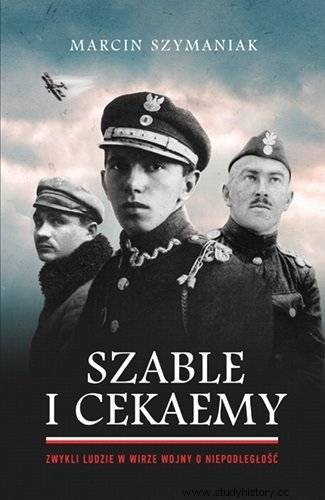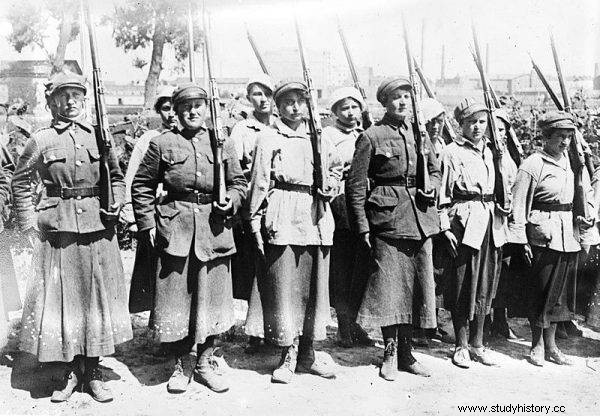During the wars for Poland in 1914–21, some female patriots were eager to fight with weapons in their hands. The male commanders, however, saw the ladies mainly as nurses, cooks or ... front prostitutes.
“I had an incident with which I didn't quite know how to deal with. Here is my wife unexpectedly joined in September 1915 in Lublin to the 2nd Brigade of the Polish Legions and in full gear set off to the combat front of the World War! " - wrote the artist-painter Zygmunt Kamiński, recalling one of the most shocking events of his life.
The painter's wife, Zofia Trzcińska-Kamińska, a 24-year-old sculptor, cut her hair, got herself a uniform and sneaked out of the house. Posing as a man, under the assumed name of Zygmunt Tarło, she "screwed" into the cavalry.
Temporary sex change
She had no doubts about the makings of a soldier. Her husband described her as follows:“beautiful growth, good, strong figure, showing great condition of excellent nutrition for many generations. (…) You could feel her self-confidence, absolute courage and impetuosity ”. Despite this, Mr. Zygmunt decided that his wife's going to war was a very bad idea.
The whole family had similar feelings. In the midst of cursings and lamentations, efforts were made to bring the "madwoman" back home. The search ended quite quickly with success. After 1.5 months, "Zygmunt Tarło" was exposed as a woman and sent back to her husband. Instead of fighting for Poland in the Legions, Zofia, after washing her head thoroughly by her family, politely went to study sculpture at the Warsaw School of Fine Arts.
It was extremely difficult for women like Zofia to fulfill their dreams of smelling gunpowder. Józef Piłsudski, the creator of the Legions, did not want them in the trenches. Before the outbreak of World War I, he had at his disposal female rifle teams, numbering about 300 volunteers, but after the first fights he ordered them to be dismantled. On September 10, 1914, he ordered that the "women following the army" be sent back to Krakow. The reason was most likely the attitude of the commanders and male soldiers, very reluctant to the perspective of fighting alongside "women".

Wanda Gertz enlisted in the army disguised as a man
For women who were eager to fight, there was a radical option:temporary sex change. Some, like Zofia Kamińska, fell quickly, but many others were more lucky. 18-year-old Wanda Gertz decided that she would at least become a non-commissioned officer, although - as she wrote herself - "at that time it was unthinkable that a girl could be a soldier" . Disguised as a man, Gertz stood in line for the admissions committee.
Somehow she managed to get away from the medical examinations, which would inevitably end in disclosure. The fellow recruits, however, immediately smelled the writing with their noses. "The sergeant said you were a woman in disguise and that is why you did not go to the inspection," one of them said aggressively. "The sergeant said the same about you!" The recruit retorted consciously.
Acting under the name of Kazimierz Żuchowicz, she began her artillery service. Petite and not very strong, she had great difficulty following some orders. For example, she admitted that pulling the poles out of the frozen ground required superhuman effort. For fear of being exposed, she also avoided doctors, which was very dangerous. Both when a horse kicked her, severely injuring her leg, and after partially losing her eyesight, she refused to seek medical attention.
"Grażyny" in the Polish army
Despite enormous difficulties, Gertz managed to make his dreams come true. When in 1918 independent Poland began to revive, the first female military formations were established - the Volunteer Women's Legion. The distinguished soldier became the commandant of the Vilnius branch of OLK and took part in the battles for the city with the Bolsheviks. “Handsome and quick-witted. She wore the uniform of the Women's Battalion - a khaki jacket, a blue skirt, a tight cap and high boots, "the Times correspondent wrote about her. She ended her military career with the rank of major, well above her youthful aspirations.
Wanda Gertz, however, was one of the few women who fought in the combat units. Most of the women who "screwed" into the army served as nurses, sentinels, in pots and stewards. Commanders often recognized the women despite their disguise and sent them to light duty. My colleagues called their comrades-in-arms "Grażyna", in reference to the brave heroine of Mickiewicz's poem.

The text is a fragment of Marcin Szymaniak's book "Szable i Cekaemy", which has just been released by Znak Horyzont Publishing House.
After 1918, "Grażyn" came more. Already at the beginning of November this year, Polish-Ukrainian fights for Lviv broke out, then the Polish-Bolshevik front was formed in Belarus and Ukraine. The Polish Army, created in haste, recruited women to auxiliary formations - guard, sanitary, provisioning and courier. Battle service was still out of the question, at least in theory.
In December 1919, in the Ministry of Military Affairs it was decided that women would be very useful at the front in a different role - prostitutes. Work began on a project to create a network of field brothels for soldiers, which could reduce the number of rapes on the inhabitants of the frontier areas and the spread of venereal diseases.
When Aleksandra Zagórska, the commander of the Volunteer Women's Legion, found out about this idea, she immediately felt indignant and ran to Piłsudski in protest. The army chief succumbed to her arguments and the brothel project was dropped.
On the first line
Zagórska, 36, complained a lot about the mistreatment and disregard of women in the army. But she and the other women were both gritting their teeth and doing their job. Zagórska's associate, Helena Bujwid, flatly refused to serve as a nurse and fought in Lviv with weapons in hand, distinguishing herself with accurate shooting.
The sanitary or courier service was considered less glorious, which does not mean that it was less dangerous. During the attacks, the nurses ran right behind the soldiers, looking for the wounded and giving them first aid . During the fights with the Bolsheviks on the Berezina river in August 1919, two orderlies - Zdziarska and Jasiński - followed the advancing infantry company. At one point, Maria Zdziarska recalled:
Jasiński was killed on the spot. I was completely alone. There are more and more injured, the shooting is getting denser, because they are giving us shrapnel as well. I walk in the open field because there are no ditches. Not only do the crutches whistle around the ears, but again and again some people swat their clothes, a haversack with bandages or a cap. (...) that one day I had twenty-five wounded and three killed, out of ninety people.
Zdziarska encountered a contemptuous attitude towards women more than once, and complained about the thievery and drunkenness in the army. She was very much afraid of rape, both by the Bolsheviks and her own. During the chaotic retreat of Poles from Kiev in June 1920, she was looking for the "Paderewski" armored train to deal with the wounded. She tried to avoid Polish troops withdrawing in disorder.
“Some of the soldiers were drunk:the alcohol depots in Kiev, which could not be taken away, fell into the hands of the soldiers. For fear of drunkards, I tried to avoid groups and military units from a distance. I had to go through fields, fields, "she wrote.
Forgotten Heroes
A total of about 2,000 women took part in the war with the Bolsheviks. Only in the face of a direct threat to Warsaw by the Red Army, a strictly combat women's unit was created - the Line Battalion of the Volunteer Women's Legion. The nearly 400-strong battalion did not take direct part in the Battle of Warsaw, and after the defeat of the Red Army, it was sent to catch Russian refugees in the woods.

Female soldiers from the Volunteer Legion of Women during the Polish-Bolshevik War
Not all female soldiers managed to survive the war. Right after the Battle of Warsaw, for example, 21-year-old nurse Teresa Grodzińska, lost her life. During the September fights over the Huczwa, she was taken prisoner; the Red Army imprisoned her in a barn, and then probably tried to rape her. Grodzińska grabbed the ax and tried to defend herself. She was killed with sabers by angry Russians.
After the end of the war, the merits and sacrifice of women were quickly forgotten. The Volunteer Women's Legion was liquidated in 1922, to the undisguised satisfaction of the officer corps and the great sorrow of the female volunteers. One of them, Maria Wittek, wrote:
Dismissing legionnaires from the army was the hardest job for them. Some of them were left destitute and homeless in the winter months. They walked away with a feeling of great harm, which they believed had been done to them by the military to which they were fully committed.
Source:
The text is a fragment of Marcin Szymaniak's book "Szable i Cekaemy", which has just been released by Znak Horyzont Publishing House.
